Berg J.M., Tymoczko J.L., Stryer L. Biochemistry
Подождите немного. Документ загружается.

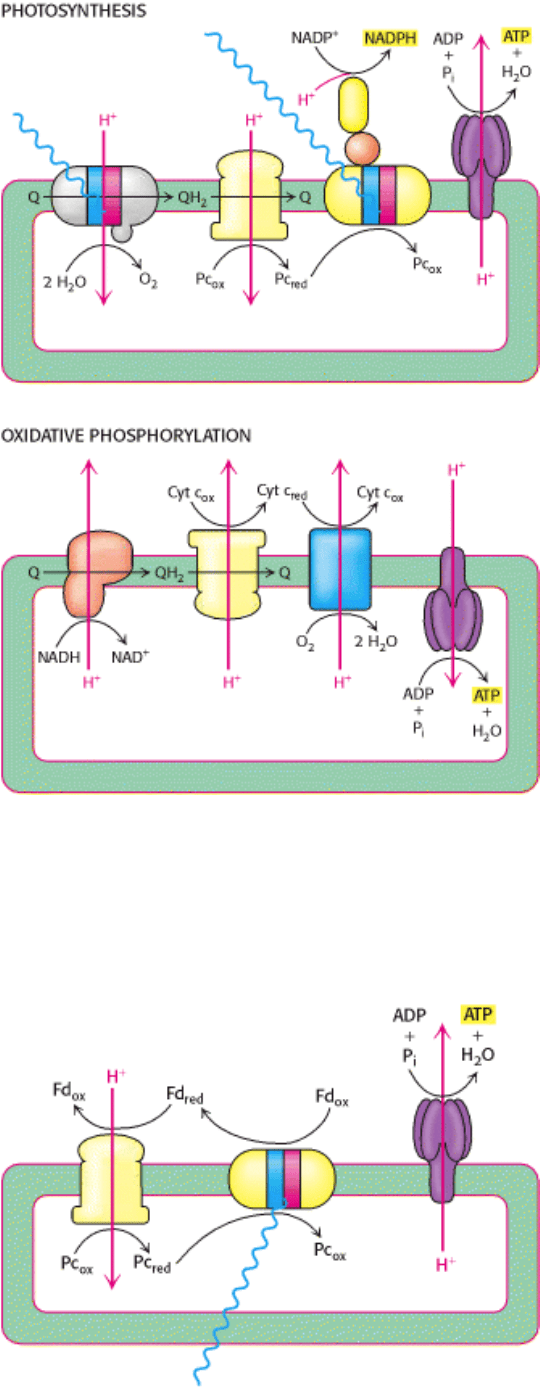
Figure 19.25. Comparison of Photosynthesis and Oxidative Phosphorylation. The light-induced electron transfer in
photosynthesis drives protons into the thylakoid lumen. The excess protons flow out of the lumen through ATP synthase
to generate ATP in the stroma. In oxidative phosphorylation, electron flow down the electron-transport chain pumps
protons out of the mitochondrial matrix. Excess protons from the intermembrane space flow into the matrix through ATP
synthase to generate ATP in the matrix.
II. Transducing and Storing Energy 19. The Light Reactions of Photosynthesis 19.4. A Proton Gradient Across the Thylakoid Membrane Drives ATP Synthesis
Figure 19.26. Cyclic Photophosphorylation. In this pathway, electrons from reduced ferredoxin are transferred to the
cytochrome bf complex rather than to ferredoxin-NADP
+
reductase. The flow of electrons through cytochrome bf pumps

protons into the thylakoid lumen. These protons flow through ATP synthase to generate ATP. Neither NADPH nor O
2
is
generated by this pathway.
II. Transducing and Storing Energy 19. The Light Reactions of Photosynthesis
19.5. Accessory Pigments Funnel Energy Into Reaction Centers
A light-harvesting system that relied only on the chlorophyll a molecules of the special pair would be rather inefficient
for two reasons. First, chlorophyll a molecules absorb light only at specific wavelengths (see Figure 19.6). A large gap is
present in the middle of the visible regions between approximately 450 and 650 nm. This gap corresponds to the peak of
the solar spectrum, so failure to collect this light would constitute a considerable lost opportunity. Second, even in
spectral regions where chlorophyll a absorbs light, many photons would pass through without being absorbed, owing to
the relatively low density of chlorophyll a molecules in a reaction center. Accessory pigments, both additional
chlorophylls as well as other classes of molecules, are closely associated with reaction centers. These pigments absorb
light and funnel the energy to the reaction center for conversion into chemical forms. Indeed, experiments in 1932 by
Robert Emerson and William Arnold on Chlorella cells (unicellular green algae) demonstrated that only 1 molecule of
O
2
was produced for 2500 chlorophyll molecules excited.
19.5.1. Resonance Energy Transfer Allows Energy to Move from the Site of Initial
Absorbance to the Reaction Center
How is energy funneled from an associated pigment to a reaction center? We have already seen how the absorption of a
photon can lead to electron excitation and transfer (Section 19.2). Another reaction to photon absorption, not leading to
electron transfer, is more common. Through electromagnetic interactions through space, the excitation energy can be
transferred from one molecule to a nearby molecule (Figure 19.27). The rate of this process, called resonance energy
transfer, depends strongly on the distance between the energy donor and the energy acceptor molecules; an increase in
the distance between the donor and the acceptor by a factor of two typically results in a decrease in the energy-transfer
rate by a factor of 2
6
= 64. For reasons of conservation of energy, energy transfer must be from a donor in the excited
state to an acceptor of equal or lower energy. The excited state of the special pair of chlorophyll molecules is lower in
energy than that for single chlorophyll molecules, allowing reaction centers to trap the energy transferred from other
molecules (Figure 19.28).
19.5.2. Light-Harvesting Complexes Contain Additional Chlorophylls and Carotinoids
Chlorophyll b and carotenoids are important light-harvesting molecules that funnel energy to the reaction center.
Chlorophyll b differs from chlorophyll a in having a formyl group in place of a methyl group. This small difference
moves its two major absorption peaks toward the center of the visible region. In particular, chlorophyll b efficiently
absorbs light with wavelengths between 450 and 500 nm (Figure 19.29).
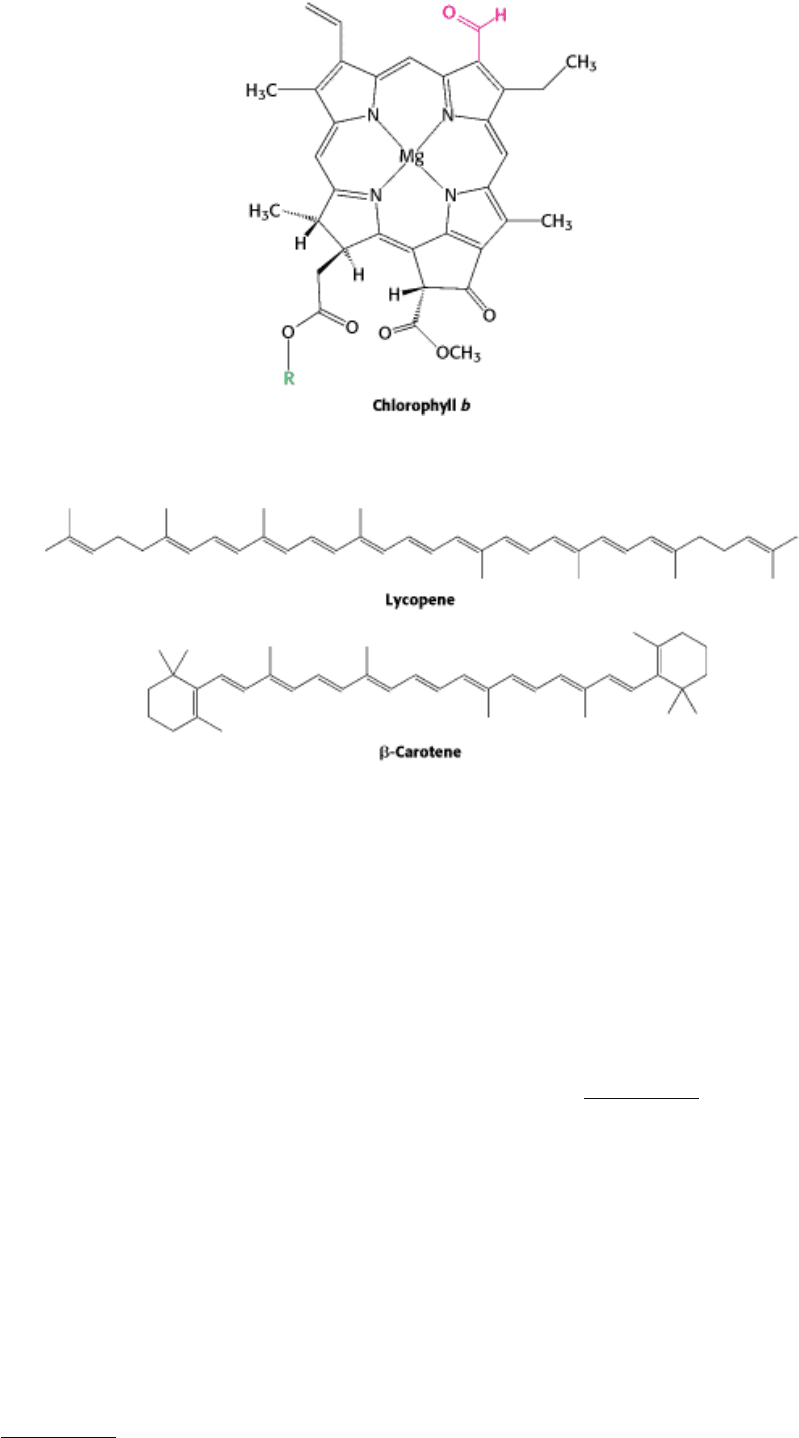
Carotenoids are extended polyenes that also absorb light between 400 and 500 nm.
The carotenoids are responsible for most of the yellow and red colors of fruits and flowers, and they provide the
brilliance of fall, when the chlorophyll molecules are degraded to reveal the carotenoids.
In addition to their role in transferring energy to reaction centers, the carotenoids serve a safeguarding function.
Carotenoids suppress damaging photochemical reactions, particularly those including oxygen, that can be induced by
bright sunlight. Indeed, plants lacking carotenoids are quickly killed on exposure to light and oxygen.
The accessory pigments are arranged in numerous light-harvesting complexes that completely surround the reaction
center. The 26-kd subunit of light-harvesting complex II (LHC-II) is the most abundant membrane protein in
chloroplasts. This subunit binds seven chlorophyll a molecules, six chlorophyll b molecules, and two carotenoid
molecules. Similar lightharvesting assemblies exist in photosynthetic bacteria (Figure 19.30).
19.5.3. Phycobilisomes Serve as Molecular Light Pipes in Cyanobacteria and Red Algae
Little blue or red light reaches algae living at a depth of a meter or more in seawater, because such light is absorbed by
water and by chlorophyll molecules in organisms lying above. How can photosynthetic organisms survive under such
conditions? Cyanobacteria (blue-green algae) and red algae contain large protein assemblies called phycobilisomes that
enable them to harvest the green and yellow light that penetrates to their ecological niche. Phycobilisomes are bound to
the outer face of the thylakoid membrane, where they serve as light-absorbing antennas to funnel excitation energy into
the reaction centers of photosystem II. They absorb maximally in the 470- to 650-nm region, in the valley between the
blue and far-red absorption peaks of chlorophyll a. Phycobilisomes are very large assemblies (several million daltons) of
many phycobiliprotein subunits, each containing many covalently attached bilin prosthetic groups, as well as linker
polypeptides (Figure 19.31). Phycobilisomes contain hundreds of bilins. Phycocyanobilin and phycoerythrobilin are the
two most common ones.
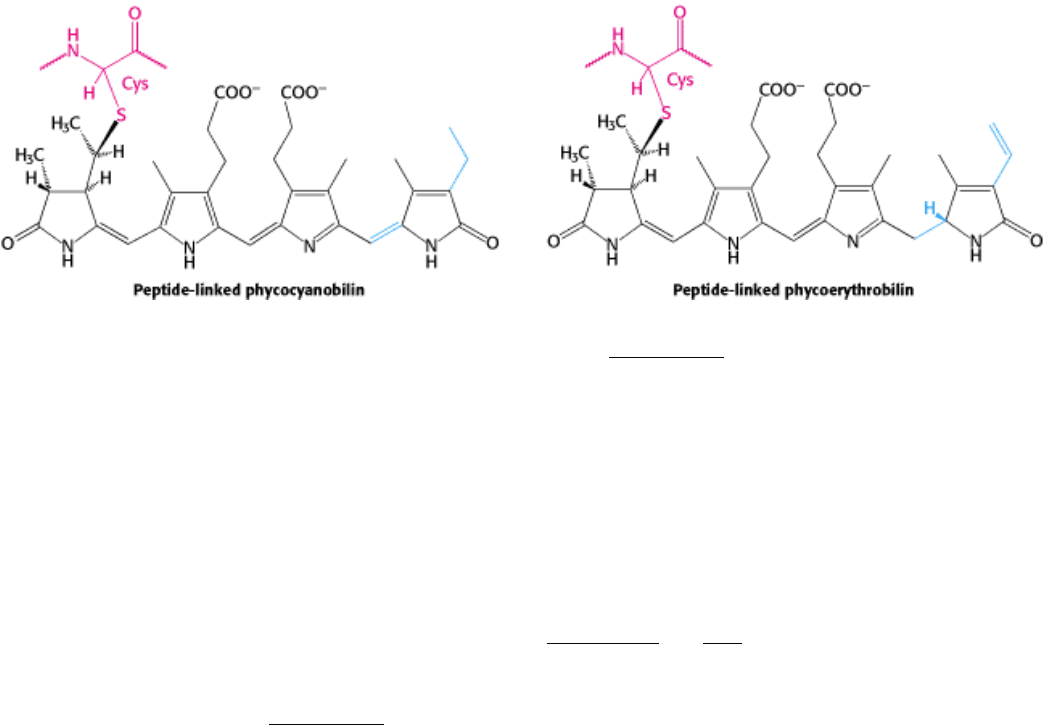
The geometrical arrangement of phycobiliproteins in phycobilisomes (Figure 19.32), as well as their spectral properties,
contributes to the efficiency of energy transfer, which is greater than 95%. Excitation energy absorbed by phycoerythrin
subunits at the periphery of these antennas appears at the reaction center in less than 100 ps. Phycobilisomes are
elegantly designed light pipes that enable algae to occupy ecological niches that would not support organisms relying
solely on chlorophyll for the trapping of light.
19.5.4. Components of Photosynthesis Are Highly Organized
The complexity of photosynthesis, seen already in the elaborate interplay of complex components, extends even to the
placement of the components in the thylakoid membranes. Thylakoid membranes of most plants are differentiated into
stacked (appressed) and unstacked (nonappressed) regions (see Figures 19.1 and 19.3). Stacking increases the amount of
thylakoid membrane in a given chloroplast volume. Both regions surround a common internal thylakoid space, but only
unstacked regions make direct contact with the chloroplast stroma. Stacked and unstacked regions differ in the nature of
their photosynthetic assemblies (Figure 19.33). Photosystem I and ATP synthase are located almost exclusively in
unstacked regions, whereas photosystem II is present mostly in stacked regions. The cytochrome bf complex is found in
both regions. Indeed, this complex rapidly moves back and forth between the stacked and unstacked regions.
Plastoquinone and plastocyanin are the mobile carriers of electrons between assemblies located in different regions of
the thylakoid membrane. A common internal thylakoid space enables protons liberated by photosystem II in stacked
membranes to be utilized by ATP synthase molecules that are located far away in unstacked membranes.
What is the functional significance of this lateral differentiation of the thylakoid membrane system? The positioning of
photosystem I in the unstacked membranes also gives it direct access to the stroma for the reduction of NADP
+
. ATP
synthase, too, is located in the unstacked region to provide space for its large CF
1
globule and to give access to ADP. In
contrast, the tight quarters of the appressed region pose no problem for photosystem II, which interacts with a small polar
electron donor (H
2
O) and a highly lipid soluble electron carrier (plastoquinone).
19.5.5. Many Herbicides Inhibit the Light Reactions of Photosynthesis
Many commercial herbicides kill weeds by interfering with the action of photosystem II or photosystem I. Inhibitors of
photosystem II block electron flow, whereas inhibitors of photosystem I divert electrons from the terminal part of this
photosystem. Photosystem II inhibitors include urea derivatives such as diuron and triazine derivatives such as atrazine.
These chemicals bind to the Q
B
site of the D1 subunit of photosystem II and block the formation of plastoquinol (QH
2
).
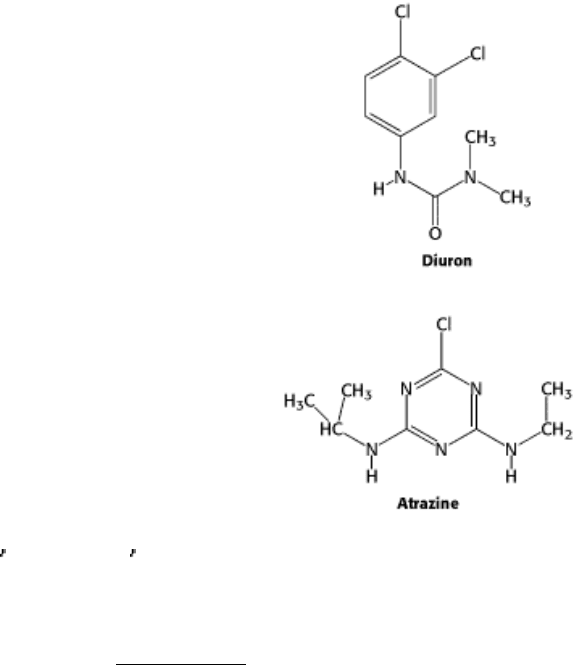
Paraquat (1,1
-dimethyl-4-4 -bipyridinium) is an inhibitor of photosystem I. Paraquat, a dication, can accept electrons
from photosystem I to become a radical. This radical reacts with O
2
to produce reactive oxygen species such as
superoxide and hydroxyl radical (OH·). Such reactive oxygen species react with double bonds in membrane lipids,
damaging the membrane (Section 18.3.6).
II. Transducing and Storing Energy 19. The Light Reactions of Photosynthesis 19.5. Accessory Pigments Funnel Energy Into Reaction Centers

Figure 19.27. Resonance Energy Transfer. Energy, absorbed by one molecule, can be transferred to nearby molecules
with excited states of equal or lower energy.
II. Transducing and Storing Energy 19. The Light Reactions of Photosynthesis 19.5. Accessory Pigments Funnel Energy Into Reaction Centers
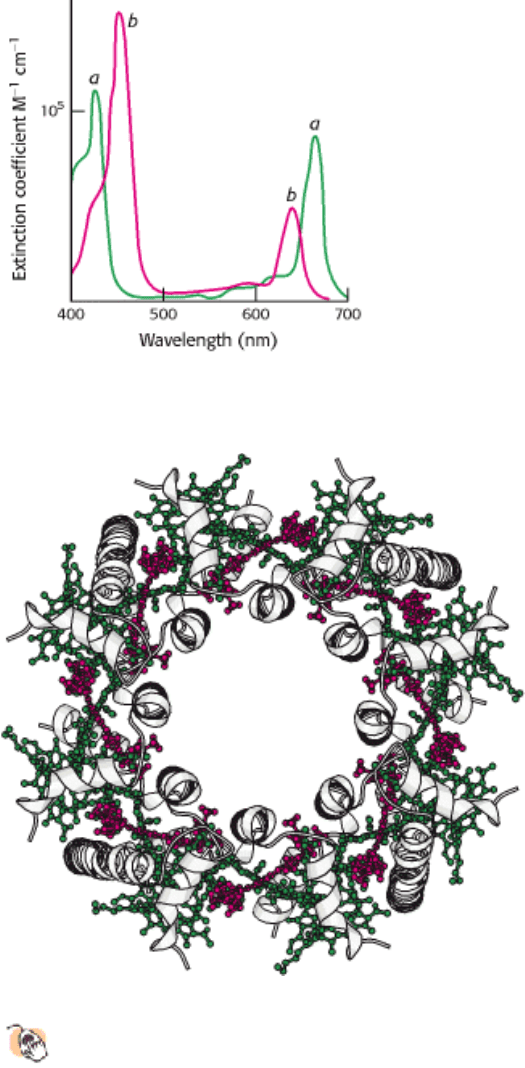
Figure 19.28. Energy Transfer from Accessory Pigments to Reaction Centers. Light energy absorbed by accessory
chlorophyll molecules or other pigments can be transferred to reaction centers, where it drives photoinduced charge
separation. The green squares represent accessory chlorophyll molecules and the red squares carotenoid molecules; the
white squares designate protein.
II. Transducing and Storing Energy 19. The Light Reactions of Photosynthesis 19.5. Accessory Pigments Funnel Energy Into Reaction Centers
Figure 19.29. Absorption Spectra of Chlorophyll. A and B .
II. Transducing and Storing Energy 19. The Light Reactions of Photosynthesis 19.5. Accessory Pigments Funnel Energy Into Reaction Centers
Figure 19.30. Structure of a Light-Harvesting Complex.
Eight polypeptides, each of which binds three chlorophyll
molecules (green) and a carotenoid molecule (red), surround a central cavity that contains the reaction center.
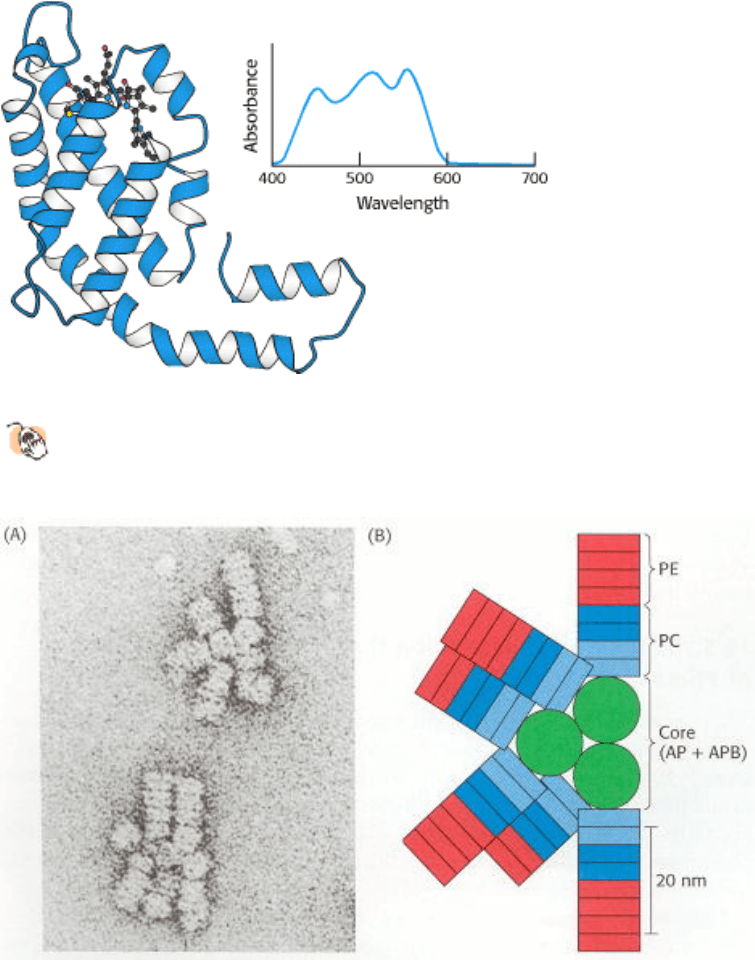
II. Transducing and Storing Energy 19. The Light Reactions of Photosynthesis 19.5. Accessory Pigments Funnel Energy Into Reaction Centers
Figure 19.31. Structure of a Phycobilisome Subunit.
This protein, a phycoerythrin, contains a phycoerythrobilin
linked to a cysteine residue. The inset shows the absorption spectrum of a phycoerythrin.
II. Transducing and Storing Energy 19. The Light Reactions of Photosynthesis 19.5. Accessory Pigments Funnel Energy Into Reaction Centers
Figure 19.32. Structure of a Phycobilisome. (A) Electron micrograph of phycobilisomes from a cyanobacterium
(Synechocystis). (B) Schematic representation of a phycobilisome from the cyanobacterium Synechocystis 6701. Rods
containing phycoerythrin (PE) and phycocyanin (PC) emerge from a core made of allophycocyanin (AP) and
allophycocyanin B (APB). The core region binds to the thylakoid membrane. [(A) Courtesy of Dr. Robley Williams and
Dr. Alexander Glazer; (B) after a drawing kindly provided by Dr. Alexander Glazer.]
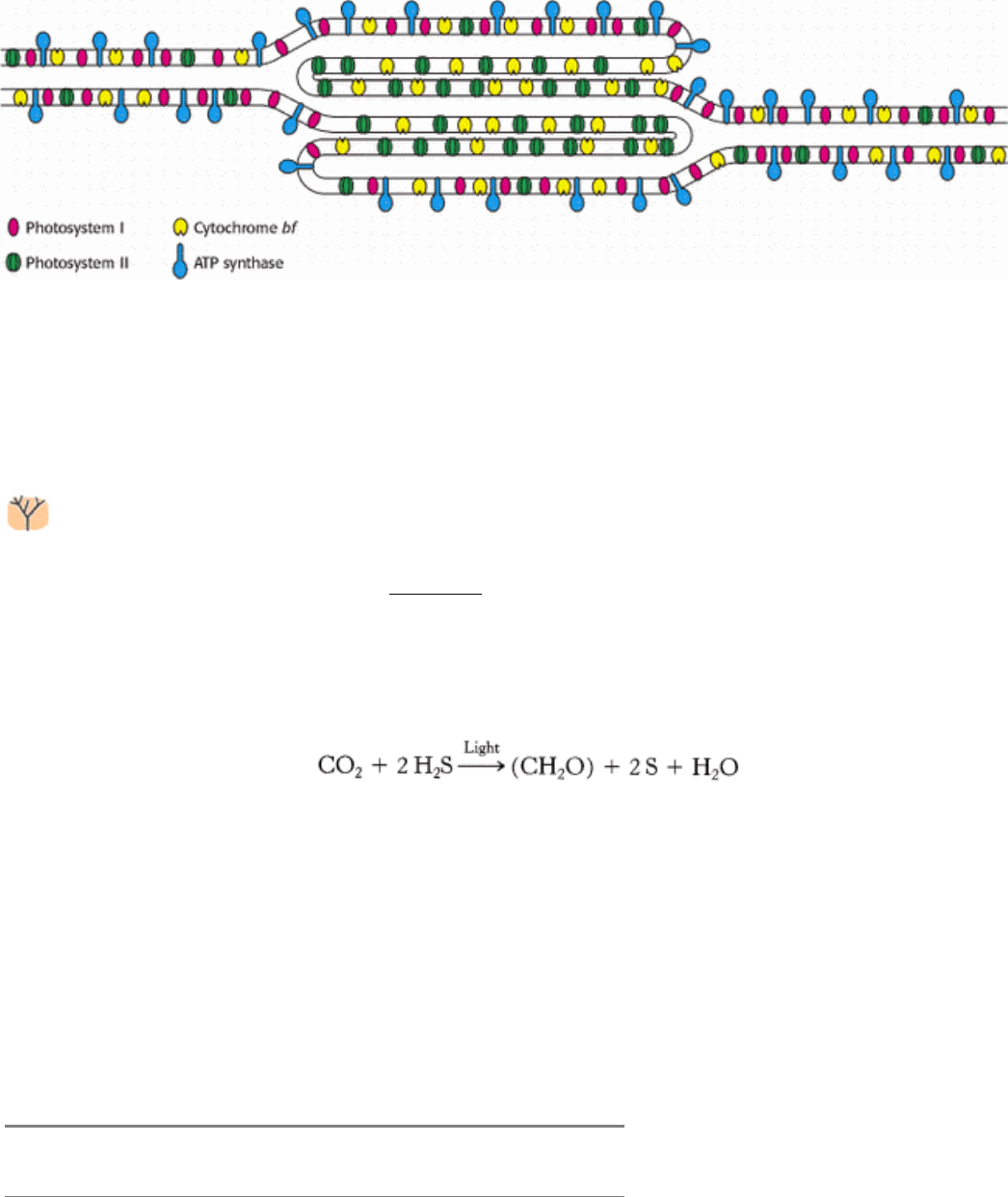
II. Transducing and Storing Energy 19. The Light Reactions of Photosynthesis 19.5. Accessory Pigments Funnel Energy Into Reaction Centers
Figure 19.33. Location of Photosynthesis Components. Photosynthetic assemblies are differentially distributed in the
stacked (appressed) and unstacked (nonapressed) regions of thylakoid membranes. [After a drawing kindly provided by
Dr. Jan M. Anderson and Dr. Bertil Andersson.]
II. Transducing and Storing Energy 19. The Light Reactions of Photosynthesis
19.6. The Ability to Convert Light Into Chemical Energy Is Ancient
The ability to convert light energy into chemical energy is a significant evolutionary advantage. Indeed,
photosynthesis arose early in the history of life on Earth, which began about 3.5 billion years ago. Geolog- ical
evidence suggests that oxygenic photosynthesis became important approximately 2 billion years ago. Anoxygenic
photosynthetic systems existed even earlier (Table 19.1). The photosynthetic system of the nonsulfur purple bacterium
Rhodospeudomonas viridis has most features common to oxygenic photosynthetic systems and clearly predates them.
Green sulfur bacteria such as Chlorobium thiosulfatophilum carry out a reaction that also seems to have appeared before
oxygenic photosynthesis and is even more similar to oxygenic photosynthesis than that of R. viridis . Reduced sulfur
species such as H
2
S are electron donors in the overall photosynthetic reaction:
Nonetheless, photosynthesis did not evolve immediately at the origin of life. The failure to discover photosynthesis in the
domain of Archaea implies that photosynthesis evolved exclusively in the domain of Bacteria. Eukaryotes appropriated
through endosymbiosis the basic photosynthetic units that were the products of bacterial evolution. All domains of life
do have electron-transport chains in common, however. As we have seen, components such as the ubiquinone-
cytochrome c oxidoreductase and cytochrome bf family are present in both respiratory and photosynthetic electron-
transport chains. These components were the foundations on which light-energy-capturing systems evolved.
II. Transducing and Storing Energy 19. The Light Reactions of Photosynthesis 19.6. The Ability to Convert Light Into Chemical Energy Is Ancient
Table 19.1. Major Groups of Photosynthetic Prokaryotes
Bacteria Photosynthetic electron donor O
2
use
Green sulfur H
2
, H
2
S, S Anoxygenic
Green nonsulfur Variety of amino acids and organic acids Anoxygenic
Purple sulfur H
2
, H
2
S, S Anoxygenic
Purple nonsulfur Usually organic molecules Anoxygenic

Cyanobacteria H
2
O Oxygenic
II. Transducing and Storing Energy 19. The Light Reactions of Photosynthesis
Summary
Photosynthesis Takes Place in Chloroplasts
The proteins that participate in the light reactions of photosynthesis are located in the thylakoid membranes of
chloroplasts. The light reactions result in (1) the creation of reducing power for the production of NADPH, (2) the
generation of a transmembrane proton gradient for the formation of ATP, and (3) the production of O
2
.
Light Absorption by Chlorophyll Induces Electron Transfer
Chlorophyll molecules
tetrapyrroles with a central magnesium ion absorb light quite efficiently because they are
polyenes. An electron excited to a high-energy state by the absorption of a photon can move to nearby electron
acceptors. In photosynthesis, an excited electron leaves a pair of associated chlorophyll molecules known as the special
pair. The functional core of photosynthesis, a reaction center, from a photosynthetic bacterium has been studied in great
detail. In this system, the electron moves from the special pair (containing bacteriochlorophyll) to a bacteriopheophytin
(a bacteriochlorophyll lacking the central magnesium ion) to quinones. The reduction of quinones leads to the generation
of a proton gradient, which drives ATP synthesis in a manner analogous to that of oxidative phosphorylation.
Two Photosystems Generate a Proton Gradient and NADPH in Oxygenic
Photosynthesis.
Photosynthesis in green plants is mediated by two linked photosystems. In photosystem II, excitation of P680, a special
pair of chlorophyll molecules located at the interface of two similar subunits, leads to electron transfer to plastoquinone
in a manner analogous to that for the bacte-rial reaction center. The electrons are replenished by the extraction of
electrons from water at a center containing four manganese ions. One molecule of O
2
is generated at this center for each
four electrons transferred. The plastoquinol produced at photosystem II is reoxidized by the cytochrome bf complex,
which transfers the electrons to plastocyanin, a soluble copper protein. From plastocyanin, the electrons enter
photosystem I. In photosytem I, excitation of the special pair P700 releases electrons that flow to ferredoxin, a powerful
reductant. Ferredoxin-NADP
+
reductase, a flavoprotein located on the stromal side of the membrane, then catalyzes the
formation of NADPH. A proton gradient is generated as electrons pass through photosystem II, through the cytochrome
bf complex, and through ferredoxin-NADP
+
reductase.
A Proton Gradient Across the Thylakoid Membrane Drives ATP Synthesis
The proton gradient across the thylakoid membrane creates a proton-motive force, used by ATP synthase to form ATP.
The ATP synthase of chloroplasts (also called CF
0
-CF
1
) closely resembles the ATPsynthesizing assemblies of bacteria
and mitochondria (F
0
-F
1
). If the NADPH:NADP
+
ratio is high, electrons transferred to ferredoxin by photosystem I can
reenter the cytochrome bf complex. This process, called cyclic photophosphorylation, leads to the generation of a proton
gradient by the cytochrome bf complex without the formation of NADPH or O
2
.
Accessory Pigments Funnel Energy into Reaction Centers
Light-harvesting complexes that surround the reaction centers contain additional molecules of chlorophyll a, as well as
carotenoids and chlorophyll b molecules, which absorb light in the center of the visible spectrum. These accessory
pigments increase efficiency in light capture by absorbing light and transferring the energy to reaction centers through
